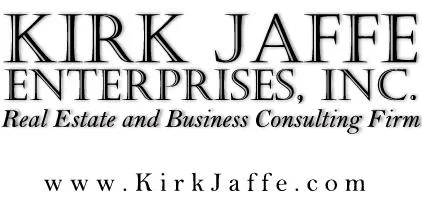Unlock Your Business's Profit Potential with the Momentum-Maker Mastermind
If you are a small business owner who wants to take your business to the next level, increase your impact, and income… Join our Next "Momentum-Maker" LIVE Session FREE
The Next Live Session is on: April 12th @9:45 AM (Pacific Time)

Our Services
Kirk Jaffe Enterprises, Inc. has multiple services for home buyers and business owners.
Make us your preferred solution for home and commercial real estate.

MORTGAGE LENDING
We offer the most competitive rates and excellent service beyond closing. Guaranteed! PRO.
REAL ESTATE AND PROFESSIONAL CONSULTING
We offer guidance to real estate professionals, tax professionals, lawyers, and CPA's.
BUSINESS CONSULTING
Are you ready to grow your business to
the next level and beyond. Kirk has helped hundreds of businesses and
can help you get there faster.
INVESTMENT ASSISTANCE
Our proven track record in solid investments has help hundreds and could help you too. Ask us how!

FIND OUT WHY KIRK JAFFE IS THE BEST CHOICE FOR LOANS AND HELPING BUSINESSES GROW!
Kirk Jaffe, CEO/Founder – Executive Management of $200MM private investment fund including Mortgage Notes, Real Estate Owned (REO) and Commercial Property Holdings. He has overseen and held executive authority of over 20,000 real estate transactions in his 20-year real estate career including buying and selling of property, foreclosure, short sale, loan modification, rehabilitation of property with an aggregate over $1 Billion value. Kirk has also originated over $ 1 Billion of new Mortgages.
Kirk is the past President of the Universal City/North Hollywood Chamber of Commerce as well as a former co-chair of the ALFN Commercial Practices Committee. He is active as a speaker and moderator of several trade organizations including the CA Mortgage Bankers Association (CMBA), Mortgage Banking Association (MBA), and the Attorney Legal Financial Network (ALFN). Mr. Jaffe is quoted or has been a guest of several media outlets including: KABC790 Talk Radio, NBC and the Los Angeles Daily News to name a few.
Kirk Has Appeared On:
How Can We Help
You Today?


Start Quote

Change Plan

Contact
Let Us Know What You Need!
We custom fit every service to your personal business needs. Whatever it is, we have a solution. Just click the button below to get assistance today!
If you're looking for a firm who can help you with not just your mortgage, but help you GROW YOUR BUSINESS FAST... you're where you should be!
MORTGAGE LENDING
We offer Custom Tailored mortgages for Home or Business!
BUSINESS CONSULTING
Grow your business FAST with our Business Consulting Services!
INVESTMENT CONSULTING - REAL ESTATE ASSETS
Our win/win approach to investing has helped hundreds. FIND OUT MORE!
REAL ESTATE PROFESSIONALS
If you are a real estate professional and are ready to work with a partner with years of experience, you're in the right place.
CPAS, ATTORNEYS, AND INSURANCE PROFESSIONALS
If you have questions about the potential legal implications of real estate transactions for your clients, Kirk Jaffe has the answers!
GET STARTED TODAY
Getting started with Kirk Jaffe Enterprises is super easy. Find out how it works below!
WHAT OUR CLIENTS HAVE TO SAY

“What a GREAT guy Kirk is! I highly recommend him and his services all the time and for my own home loan needs. Why would I say that as a Broker myself? Well as a Buyer and a Broker I cannot have my hand into many aspects of the transaction, so I trust Kirk with my financing needs he has yet to let me down! "
Steve Duncan

"Kirk is my go-to lender. He has worked many “miracle situations” and provides top notch service from start to finish...."
Jeff J. Grice

"I have known Kirk Jaffe for many years. Kirk has a stellar reputation. You can see his reviews by going to www.mycity.com/profile/kirk-jaffe."
Bob Friedenthal

"When I need any information regarding the Real Estate Financing space for a client, my first call is to Kirk Jaffe. He is knowledgeable, professional, and experienced. He stays on top of cases and follows up with clients. He is a true asset to my business."
Bruce Fine

"Kirk works hard and well day and night, a kind person and gets it done fast!"
Melissa Oppenheimer

"Kirk did a fabulous job. He walked me thru the process and it was incredibly easy compared to other mortgages I've done. Thanks to Kirk, my house closed in under 21 days, and he got me a great interest rate."
CHARLIE JEWETT

WHY WORK WITH KIRK JAFFE ENTERPRISES, INC?
Because we offer the best service at affordable rates and will help your company grow faster! Click the button or
CALL US AT (775) 415 - KIRK (5475)

We finally know what caused the global tech outage - and how much it cost
Insurers have begun calculating the financial damage caused by last week’s devastating CrowdStrike software glitch that crashed computers, canceled flights and disrupted hospitals all around the globe — and the picture isn’t pretty.
What’s been described as the largest IT outage in history will cost Fortune 500 companies alone more than $5 billion in direct losses, according to one insurer’s analysis of the incident published Wednesday.
The new figures put into stark relief how a single automated software update brought much of the global economy to a sudden halt — revealing the world’s overwhelming dependence on a key cybersecurity company — and what it will take to recover.
The estimates come the same day that CrowdStrike issued a preliminary report on how it inadvertently caused the widespread IT meltdown. It is the most detailed technical analysis to date of the outage.
Businesses are scrambling to recover – especially Delta Air Lines. Delta is still dealing with fallout from the glitch, as thousands of flights have been canceled. The Department of Transportation is investigating.
Numerous Fortune 500 companies use CrowdStrike’s cybersecurity software to detect and block hacking threats. But when CrowdStrike issued an update last week to its signature cybersecurity software, known as Falcon, millions of computers around the world running Microsoft Windows crashed because of the way that the update interacted with Windows.
The health care and banking sectors were the hardest hit by CrowdStrike’s mishap, with estimated losses of $1.94 billion and $1.15 billion, respectively, said Parametrix, the cloud monitoring and insurance firm behind Wednesday’s analysis.
Fortune 500 airlines such as American and United were the next most affected, losing a collective $860 million, Parametrix said.
All told, the outage may have cost Fortune 500 companies as much as $5.4 billion in revenues and gross profit, Parametrix said, not counting any secondary losses that may be attributed to lost productivity or reputational damage. Only a small portion, around 10% to 20%, may be covered by cybersecurity insurance policies, Parametrix added.
Fitch Ratings, one of the largest US credit ratings agencies, said Monday that the types of insurance likely to see the most claims stemming from the outage include business interruption insurance, travel insurance and event cancellation insurance.
“This incident highlights a growing risk of single points of failure,” Fitch said in a blog post, warning that such single points of failure “are likely to increase as companies seek consolidation to take advantage of scale and expertise, resulting in fewer vendors with higher market shares.”
The eye-popping damage estimates underscore how a preventable mistake at one of the world’s most dominant cybersecurity firms has had cascading effects for the global economy — and may prompt more calls for CrowdStrike to be held accountable.
What went wrong
On Wednesday, CrowdStrike released a report outlining the initial results of its investigation into the incident, which involved a file that helps CrowdStrike’s security platform look for signs of malicious hacking on customer devices.
The company routinely tests its software updates before pushing them out to customers, CrowdStrike said in the report. But on July 19, a bug in CrowdStrike’s cloud-based testing system — specifically, the part that runs validation checks on new updates prior to release — ended up allowing the software to be pushed out “despite containing problematic content data.”
The bad release was published just after midnight Eastern time on July 19, and rolled back an hour and a half later, at 1:27 a.m. Eastern, CrowdStrike said. But by then millions of computers had already automatically downloaded the faulty update. The issue affected only Windows devices, not Mac or Linux machines, and only those that were switched on and able to receive updates during those early morning hours.
Thanks to the timing of the incident, organizations in Europe and Asia “had more of their work day affected by the outage, unlike the Americas,” Fitch wrote in its blog post.
When Windows devices using CrowdStrike’s cybersecurity tools tried to access the flawed file, it caused an “out-of-bounds memory read” that “could not be gracefully handled, resulting in a Windows operating system crash,” CrowdStrike said.
That’s the Blue Screen of Death that many people reported seeing on their machines, and that only a manual intervention to delete the bad file could fix — a slow, painstaking process when you consider that as many as 8.5 million individual devices will need to be reset this way.
That figure is small as a percentage of the wider Windows ecosystem, said Microsoft — a company that played no direct role in the outage. Still, Microsoft said in a blog post, it “demonstrates the interconnected nature of our broad ecosystem.”
CrowdStrike said that the testing and validation system that approved the bad software update had appeared to function normally for other releases made earlier in the year. But it pledged Wednesday to keep software glitches like last week’s from happening again, and to publicly release a more detailed analysis when it becomes available.
The company added that it is developing a new check for its validation system “to guard against this type of problematic content from being deployed in the future.”
And CrowdStrike said it also plans to move to a staggered approach to releasing content updates so that not everyone receives the same update at once, and to give customers more fine-grained control over when the updates are installed.
Insurers have begun calculating the financial damage caused by last week’s devastating CrowdStrike software glitch that crashed computers, canceled flights and disrupted hospitals all around the globe — and the picture isn’t pretty.
What’s been described as the largest IT outage in history will cost Fortune 500 companies alone more than $5 billion in direct losses, according to one insurer’s analysis of the incident published Wednesday.
The new figures put into stark relief how a single automated software update brought much of the global economy to a sudden halt — revealing the world’s overwhelming dependence on a key cybersecurity company — and what it will take to recover.
The estimates come the same day that CrowdStrike issued a preliminary report on how it inadvertently caused the widespread IT meltdown. It is the most detailed technical analysis to date of the outage.
Businesses are scrambling to recover – especially Delta Air Lines. Delta is still dealing with fallout from the glitch, as thousands of flights have been canceled. The Department of Transportation is investigating.
Numerous Fortune 500 companies use CrowdStrike’s cybersecurity software to detect and block hacking threats. But when CrowdStrike issued an update last week to its signature cybersecurity software, known as Falcon, millions of computers around the world running Microsoft Windows crashed because of the way that the update interacted with Windows.
The health care and banking sectors were the hardest hit by CrowdStrike’s mishap, with estimated losses of $1.94 billion and $1.15 billion, respectively, said Parametrix, the cloud monitoring and insurance firm behind Wednesday’s analysis.
Fortune 500 airlines such as American and United were the next most affected, losing a collective $860 million, Parametrix said.
All told, the outage may have cost Fortune 500 companies as much as $5.4 billion in revenues and gross profit, Parametrix said, not counting any secondary losses that may be attributed to lost productivity or reputational damage. Only a small portion, around 10% to 20%, may be covered by cybersecurity insurance policies, Parametrix added.
Fitch Ratings, one of the largest US credit ratings agencies, said Monday that the types of insurance likely to see the most claims stemming from the outage include business interruption insurance, travel insurance and event cancellation insurance.
“This incident highlights a growing risk of single points of failure,” Fitch said in a blog post, warning that such single points of failure “are likely to increase as companies seek consolidation to take advantage of scale and expertise, resulting in fewer vendors with higher market shares.”
The eye-popping damage estimates underscore how a preventable mistake at one of the world’s most dominant cybersecurity firms has had cascading effects for the global economy — and may prompt more calls for CrowdStrike to be held accountable.
What went wrong
On Wednesday, CrowdStrike released a report outlining the initial results of its investigation into the incident, which involved a file that helps CrowdStrike’s security platform look for signs of malicious hacking on customer devices.
The company routinely tests its software updates before pushing them out to customers, CrowdStrike said in the report. But on July 19, a bug in CrowdStrike’s cloud-based testing system — specifically, the part that runs validation checks on new updates prior to release — ended up allowing the software to be pushed out “despite containing problematic content data.”
The bad release was published just after midnight Eastern time on July 19, and rolled back an hour and a half later, at 1:27 a.m. Eastern, CrowdStrike said. But by then millions of computers had already automatically downloaded the faulty update. The issue affected only Windows devices, not Mac or Linux machines, and only those that were switched on and able to receive updates during those early morning hours.
Thanks to the timing of the incident, organizations in Europe and Asia “had more of their work day affected by the outage, unlike the Americas,” Fitch wrote in its blog post.
When Windows devices using CrowdStrike’s cybersecurity tools tried to access the flawed file, it caused an “out-of-bounds memory read” that “could not be gracefully handled, resulting in a Windows operating system crash,” CrowdStrike said.
That’s the Blue Screen of Death that many people reported seeing on their machines, and that only a manual intervention to delete the bad file could fix — a slow, painstaking process when you consider that as many as 8.5 million individual devices will need to be reset this way.
That figure is small as a percentage of the wider Windows ecosystem, said Microsoft — a company that played no direct role in the outage. Still, Microsoft said in a blog post, it “demonstrates the interconnected nature of our broad ecosystem.”
CrowdStrike said that the testing and validation system that approved the bad software update had appeared to function normally for other releases made earlier in the year. But it pledged Wednesday to keep software glitches like last week’s from happening again, and to publicly release a more detailed analysis when it becomes available.
The company added that it is developing a new check for its validation system “to guard against this type of problematic content from being deployed in the future.”
And CrowdStrike said it also plans to move to a staggered approach to releasing content updates so that not everyone receives the same update at once, and to give customers more fine-grained control over when the updates are installed.
©CNN

CONTACT US TODAY
Need to reach us? Send us an email or give us a call today.
Kirk Jaffe Enterprises, Inc.
195 Highway 50, Ste 104-476
Stateline, NV 89449










